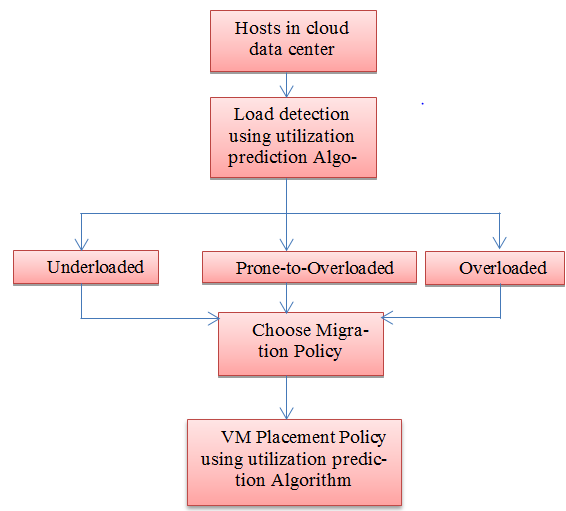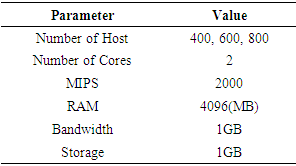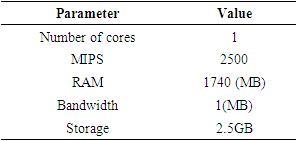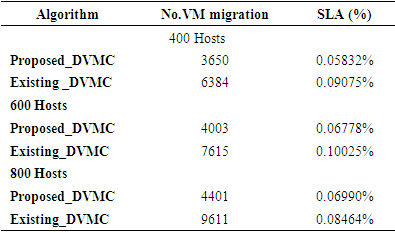-
Paper Information
- Paper Submission
-
Journal Information
- About This Journal
- Editorial Board
- Current Issue
- Archive
- Author Guidelines
- Contact Us
Computer Science and Engineering
p-ISSN: 2163-1484 e-ISSN: 2163-1492
2020; 10(1): 1-6
doi:10.5923/j.computer.20201001.01

Resource Utilization Prediction Model for Efficient Dynamic Virtual Machine Consolidation in Cloud
Muhammad I. Umar1, Kabiru I. Musa1, Musa Nehemiah1, Muhammad Aliyu2, Rumana K. Aminu3, Nahuru A. Sabongari1, 4, Mohammed K. Dauda1
1Department of Mathematical Sciences, Abubakar Tafawa Balewa University, Bauchi, Nigeria
2Department of Computer Science, Federal Polytechnic, Bauchi, Nigeria
3Department of Computer Science, F.C.T College of Education Zuba Abuja, Nigeria
4Department of Mathematical Sciences/Department of Computer Science Kaduna Polytechnic, Nigeria
Correspondence to: Muhammad I. Umar, Department of Mathematical Sciences, Abubakar Tafawa Balewa University, Bauchi, Nigeria.
| Email: |  |
Copyright © 2020 The Author(s). Published by Scientific & Academic Publishing.
This work is licensed under the Creative Commons Attribution International License (CC BY).
http://creativecommons.org/licenses/by/4.0/

Virtual Machine (VM) consolidation is an optimization approach for VM placement in cloud infrastructure, which is one of the effective ways to efficiently utilize cloud resources in order to optimize number of VM migrations, Service Level Agreement (SLA) violations and energy consumption problems. Static VM consolidation strategies have not been effective in handling variation of workloads in the cloud systems. Dynamic VM strategies have been proposed in the literatures. However, in the dynamic VM consolidation process, most existing algorithms consolidate active servers mainly based on the current resource requirements and forgo the demands of resources in the future during VM allocation. Thus, they result in needless VM migrations and cause high rate of SLA violations in data centers. This research proposed a prediction-based VM consolidation approach. The proposed method utilized a multi-resource utilization to predict the current and future CPU and memory utilization of active servers during allocation stage. The proposed method was compared with the existing one that did not consider future utilization of resources. CloudSim toolkit 3.0 simulator was used to implement and evaluate the performance of the algorithms. The proposed algorithm was found to have improved in terms of number of VM migrations and SLA violations. Using the number of hosts (400, 600, and 800), the proposed method was 28%, 32% and 38% decrease in number of VM migrations and 0.03243%, 0.03247% and 0.01474% decrease in SLA violations compared with the existing method, respectively. Recommendations and future directions were suggested for further improvements.
Keywords: Virtual Machine consolidation, Virtual Machine Migration, Service Level Agreement, Cloud Computing
Cite this paper: Muhammad I. Umar, Kabiru I. Musa, Musa Nehemiah, Muhammad Aliyu, Rumana K. Aminu, Nahuru A. Sabongari, Mohammed K. Dauda, Resource Utilization Prediction Model for Efficient Dynamic Virtual Machine Consolidation in Cloud, Computer Science and Engineering, Vol. 10 No. 1, 2020, pp. 1-6. doi: 10.5923/j.computer.20201001.01.
Article Outline
1. Introduction
- Cloud computing is an internet-based computing technology that provision shared pool of virtual computing resources transparently, on-demand and on a pay-per-use model. These virtual resources include CPU, operating platforms, storage, memory, network bandwidth etc. (Sharma & Saini, 2016; Patel & Patel, 2017). These resources are created by multiplexing the physical servers in the data centers and are shared to multiple users across the globe transparently and in isolation from each other through virtualization technology (Pietri & Sakellariou, 2016). For efficient resource management, modern cloud data centers seize the advantage of virtualization to reduce cloud computational cost and energy budgets (Ahmad, et al., 2015). However, poor utilization of these resources can lead to a lot of problems in the cloud infrastructure, such as SLA violations and VM migration problems. Under-utilization of resources is the major source of over consumption of energy in data centers, which result in poor server utilization patterns (Jain, et al., 2018). Virtualization is a powerful technology that facilitates better use of the available data center resources using a technique called VM consolidation which involves packing up of several VMs unto a single or few physical servers to reduce energy consumption and improve resource utilization in cloud data centers (Abdelsamea, et al., 2014; Damodar & Koli, 2015 and Wang & Tianfield, 2018). However, in the VM consolidation, early models, using static threshold values for host selection during the VM consolidation process have proved ineffective to handle the variation of workload in the cloud infrastructure (Sharma & Saini, 2016), therefore, recent works have more focused on the heuristics that can determine the upper and lower threshold for dynamic workloads based on the change in CPU utilization of the host server. However, Sajitha and Subhajini (2018) opined that RAM and bandwidth are also critical resources to be considered in computing load as opposed to most existing works that dwelled on CPU usage only. More so, in a dynamic VM consolidation process (Fig. 1) Abdelsamea et al (2014), most literatures based on only the current resource requirements of target host and neglected the future utilization demands during the VM allocation stage. As a result, they produce needless VM migrations (which may lead to more energy consumption in the data center) and increase the rate of SLA violations in data centers (Farahnakian et al., 2016).
 | Figure 1. Dynamic Virtual Machine Consolidation Process |
2. VM Consolidation Framework
- In the business of cloud computing, the Cloud Service Providers (CSPs) have to work hard to keep their customers (cloud users) by ensuring good Quality of Service (QoS) and meeting up with SLA agreements while at the same time improving resource utilization in the cloud infrastructure so as to obtain quick Return On Investment (ROI). VM consolidation is an efficient strategy utilized by CSPs to efficiently manage cloud resources in order to alleviate energy consumption, and maintain an uncompromising SLA agreement. Virtualization technology facilitates in reducing power consumption in data centers by creating multiple VMs onto a server and implementing the process of virtual machine consolidation (VMC) (Alboaneen, Pranggono & Tianfield, 2014; Chang, Gu & Luo, 2017). This is achieved by packing VMs unto fewer servers, ensuring optimum utilization while unused servers are shut down or hibernated to reduce energy consumption. Idle hosts are considered among the most energy consumers in the cloud data centers (Ghobaei‐Arani, et al., 2018). VM consolidation is categorized into two variants: Static and Dynamic (Ferdaus & Murshed, 2014). To achieve workload consolidation, hosts are categorized based on their utilization, namely over-loaded hosts, under loaded host and normal or idle hosts (Patel & Patel, 2017; Alboaneen, Pranggono & Tianfield, 2014). The efficient identification of over-loaded and under-loaded hosts is a key step in Dynamic VM consolidation (Motwani, et al., 2016). Dynamic consolidation process basically has the following four steps;Host Underloaded Detection: This is the problem of deciding which host is Underloaded and requiring migrating VM. Here, all VMs are migrated and the source host are switched off or hibernated. This minimizes energy consumption as the source as the number of active servers will be minimized.Host Over-loaded Detection: This is the decision of which host is over-loaded and needing VM migration. This will require migrating one or more VMs to other active host or re-activated host. This makes the hosts balanced in order to satisfy QoS such as SLA. VM Selection: This is the stage when a decision has been established to migrate VM or VMs from cold spot or hot spot. This determines which VMs will be considered candidates for migration.VM Migration: This is the actual stage of VMs migration. The migration is done considering the service downtime and resource consumption during the migration process.
3. Related Works
- Damodar & Koli (2015) proposed SLA-aware algorithm which finds and decides over-loaded host with SLA violation and proposed an efficient algorithm for finding underutilized host. They combined these algorithms to achieve energy performance trade-off. The overload detection finds overload host and get the status of ooverload host whether it result in SLA violation or not. However, the study did not consider when a host is in normal state. Alboaneen, Pranggono and Tianfield (2014) proposed a new scheme of host’s load categorization in VM consolidation framework in cloud based data centers to reduce energy consumption while meeting Quality of Service (QoS) requirements. They classified the Underloaded hosts into three further states, i.e., Underloaded, normal and critical by applying underload detection algorithms. Sharma and Saini (2016) proposed a novel method for consolidation of VMs such that it meets SLA and deals with energy-performance trade-off. For the allocation and reallocation of virtual resources depending upon their load, they used a threshold based approach, in which Median method is used to find lower and upper threshold values. An ‘Adaptive Load Detection Technique’ to detect the over-loaded and under-loaded hosts was proposed by Motwani, et al., (2016), in this work they used a famous statistical method: InterQuartile Deviation (IQD) to adaptively detect load. The proposed method obtained a better optimization in energy efficiency and performance. Chang, Gu and Luo (2017) proposed a novel VM selection policy and a resource aware utility model to guide the VM migration process. Kaur, Diwakar and Vashisht (2017) presented some alternative robust techniques to overload detection for deciding an adaptive threshold of CPU utilization and compare them with existing techniques in CloudSim simulator. The authors tried to optimize host overload detection. However, they use only CPU utilization, neglecting other critical resources parameters such as memory and network bandwidth. Shaw, Kumar and Singh (2017) proposed a novel approach of adding a constraint to the existing VM consolidation technique to avoid unnecessary VM migration. They also proposed heuristics for VM selection algorithm. A dynamic Algorithm, which considers multiple factors such as CPU, memory and bandwidth utilization of the node for empowering VM consolidation by using regression analysis model, was proposed by Sajitha and Subhajini (2018). The authors presented Energy Conscious Dynamic VM Consolidation with auto adjustment of three threshold values such as upper threshold, middle (prone-to-upper) and lower threshold. However, Network resource utilization and traffic of data center was not considered for VM placement and future resource utilization was not considered during allocation stage. Wang and Tianfield (2018) proposed a new VM placement policy, namely Space Aware Best Fit Decreasing (SABFD) and a new migration VM selection policy, namely high CPU utilization based migration VM selection (called HS). However, SABFD used only the current CPU utilization to perform consolidation.Most existing literatures, utilizing threshold-based VM consolidation strategy are mainly focused on single CPU utilization. However, power consumption by a server in data center is connected with its processor, RAM, hard disk, and bandwidth (Sajitha & Subhajini, 2018). Furthermore, most literatures considered only the current resource requirements of destination host and neglected the future utilization during the VM allocation. As a result, they generate unnecessary VM migrations (which can lead to more energy consumption in the data center) and increase the rate of SLA violations in data centers.
4. The Proposed Method
- To enhance the existing work, the proposed work considered the future utilization of both CPU and memory of host before allocating VMs. This will lead to reduced number of VM migrations and SLA violations, subsequently reducing the energy consumption in the data center. When a VM is considered for migration, it is pertinent to locate an appropriate host based on VM characteristics and overall policy pursued in the data center (Sajitha & Subhajini, 2018). The proposed approach takes into account both the current and future utilization of resources, where a regression-based model is used to approximate the future CPU and memory utilization of VMs and hosts. Figure 2 depicts the proposed resource prediction based Dynamic Virtual Machine Consolidation (DVMC) proposed in this study. This proposed approach, however, add another detection of hosts called prone-to-over-loaded. This is included to ensure hosts prone to over-loaded are assigned loads (VMs) only when they will not become over-loaded. A migration could take place only if the destination host has enough CPU and memory resources to accommodate the candidate VM at the moment and in the future time. In order to predict the resource utilization, a regression-based prediction model was used, K-Nearest Neighbor Regression (K-NNR). The prediction model estimates the resource utilization of VMs and hosts based on CPU and memory.
 | Figure 2. The Proposed Resource Prediction based DVMC Flowchart |
5. Results and Discussion
5.1. Experimental Setup
- This section presents the simulation setup, VM migration policy and experimental results and discusses the results. CloudSim toolkit 3.0 was used to simulate the different algorithms, using NetBeans IDE 8.2. The toolkit has been developed by the Cloud Computing and Distributed Systems (CLOUDS) Laboratory, University of Melbourne. It supports both system and behavior modeling of cloud system components such as data centers, Cloud Information Service (CIS), broker, VMs and resource provisioning policies (Damodar & Koli, 2015).
5.2. Simulation Setup
- Table 1 and Table 2 contain the hosts parameters and VM parameters respectively. The experiment is conducted in three scenarios, using 400, 600 and 800 number of hosts each time in other to enable the algorithms to be analyzed and evaluated based on rate SLA violations and number of migration performance metrics.
|
|
5.3. VM Selection Algorithm
- To evaluate the performance and robustness of the proposed_DVMC and Existing_DVMC algorithms, a single VM selection policy was used across the algorithms. Minimum Migration Time (MMT) was selected as the migration policy. MMT involves selecting a VM with the minimum migration time. The length of a VM migration takes as long as it needs to migrate the memory assigned to the VM over the network bandwidth link between source and destination PMs.
5.4. Performance Metrics
- The proposed approach aimed at guaranteeing that SLAs are not violated; and minimize the number of migrations. Thus, the performance of proposed algorithm is assessed through the following metrics:• SLA Violations: This measured the SLA violations due to over-utilization of resources. This indicates the percentage of time, during which active PMs have experienced the CPU or memory utilization of 100%.• Number of VM Migration: This involves the task of moving a VM from one host environment to another.Table 3 shows the results of the experiment after several rerun simulations and the average of the results are computed and tabulated. In each of the scenarios of number hosts, the proposed_DVMC shows improvement over the existing_DVMC. The number of migration of an algorithm is improved when the value is less than the value of the existing algorithm. Likewise, the percentages of SLA violations also have a noticeable improvement in the proposed_DVMC compared with the existing approach. The lower the percentage of SLA violations values, the better the algorithm.
|
 | Figure 3. VM Migration Vs. No of Hosts |
 | Figure 4. SLA violations vs. Number of Hosts |
6. Conclusions and Future Directions
- Cloud computing is a computing paradigm that comes with benefits such as low maintenance of infrastructure, up-front costs and ease of scaling for the users. However, it also comes with issues such as resource utilization, energy consumption, VM migration and service level agreement (SLA) violations among others. VM consolidation (VMC) has been utilized to address these issues. However, most literatures, utilizing threshold-based VMC strategy are mainly focused on single resource (CPU) utilization. Furthermore, most literatures considered only the current resource requirements of destination host and neglected the future utilization during the VM allocation stage. As a result, they generate needless VM migrations (which can lead to more energy consumption in the data center) and increase the rate of SLA violations in data centers. This study proposed a new method that utilized CPU and memory as well as the future utilization of these resources on the hosts during the VM placement. The proposed method utilized prediction model based on two regression-based prediction models: Linear Regression (LR) and K-Nearest Neighbor Regression (K-NNR). This proposed method helped in detecting both the current and future resource utilization on the hosts before placing VMs unto them. Experiments were carried out; the proposed method produced better results in terms of number of VM migrations and SLA violations compared with the existing method without future prediction consideration. Although, reducing number of VM migrations would lead to reduction in energy consumption in the data center, there is still need to measure energy consumption in terms of idle hosts and other factors. In the future, the researchers intend to explore more number of resources such as hard disk and bandwidth for the prediction model. Also, network utilization and traffic will be considered in order to reduce the migration cost and scalability of the proposed model.
ACKNOWLEDGEMENTS
- Authors are grateful to the reviewers of this manuscript for their expert advice. Authors are thankful to Department of Mathematical Sciences at Abubakar Tafawa Balewa University, Bauchi, Nigeria for support.
 Abstract
Abstract Reference
Reference Full-Text PDF
Full-Text PDF Full-text HTML
Full-text HTML

